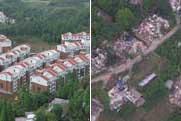China
Full text: China´s Actions for Disaster Prevention and Reduction
I. Natural Disasters in China
The natural disasters that China suffers from most have the following characteristics:
1. Diverse types. They include meteorological disasters, earthquakes, geological disasters, marine disasters, biological disasters, and forest and grassland fires. Except for modern volcanic activity, China has suffered from most types of natural disasters.
2. Wide scope of distribution. Natural disasters cause damages in different degrees to all of Chinese provinces (autonomous regions and municipalities directly under the Central Government). More than 70 percent of Chinese cities and more than 50 percent of the Chinese population are living in areas vulnerable to serious earthquakes, or meteorological, geological or marine disasters. Two thirds of China's land are threatened by floods. Tropical cyclones often batter the eastern and southern coasts, and some inland places. Droughts often occur in the northeast, northwest and north, with particularly serious ones common in southwest and south China. Destructive earthquakes with a magnitude of 5 or more on the Richter Scale have struck all the country's provinces (autonomous regions and municipalities). The mountainous and plateau areas, accounting for 69 percent of China's total land territory, suffer frequent landslides, mudrock flows and cliff collapses due to complicated geological conditions.
3. High frequency. Its monsoon climate has a strong impact on China, and causes frequent meteorological disasters. Local or regional droughts occur almost every year, while tropical cyclones, seven times a year on average, batter the east coast. As China lies right in the region where the Eurasian, Pacific and Indian Ocean plates meet, it suffers from frequent earthquakes due to still-active tectonic movements. Most of the quakes shaking China are continental, accounting for one-third of global destructive land quakes. Fires often break out in forests and on grasslands.
4. Huge losses. During the 19 years from 1990 to 2008, on annual average, natural disasters affected about 300 million people, destroyed more than 3 million buildings, and forced the evacuation of more than 9 million people. The direct financial losses caused exceeded 200 billion yuan. Floods in the Yangtze, Songhua and Nenjiang river valleys in 1998, serious droughts in Sichuan Province and Chongqing Municipality in 2006, devastating floods in the Huaihe River valley in 2007, extreme cold weather and sleet in south China in early 2008, and the earthquake that shook Sichuan, Gansu, Shaanxi and other places on May 12, 2008 all caused tremendous losses.
Now and for a fairly long time to come, the risks of extreme weather phenomena are increasing along with global climate changes. Owing to imbalanced distribution of precipitation, unusual temperature changes and other factors, the occurrences of floods and droughts, hot weather and heat waves, low-temperature rain, snow and sleet, forest and grassland fires, plant diseases, insect and animal pests may grow in number. The probability of strong and extra-strong typhoons, tempests and other disasters is quite high. The tasks of guarding against and preventing such geological disasters as mountain torrents, landsides and mud-rock flows brought about by heavy rains remain weighty. In addition, as a result of the earth's crustal movements, the danger of earthquakes is increasing.



